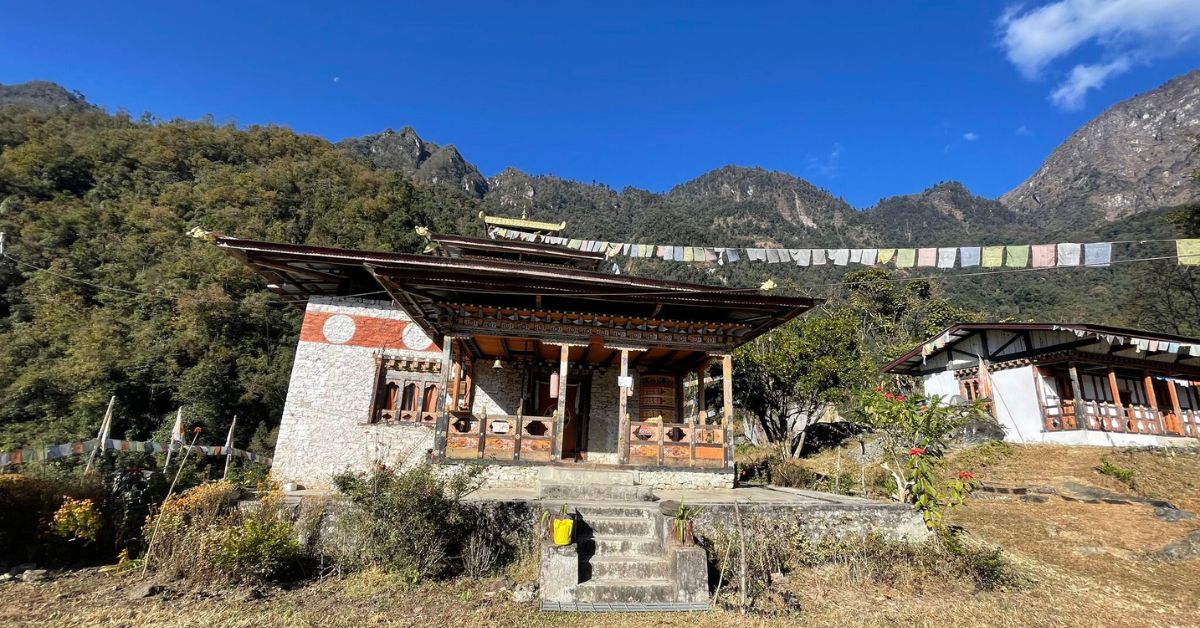Kunzangling Lhakhang is one of the eight sacred lings of Kunkhyen Longchen Rabjam (Longchenpa), founded in the 14th century. It is located in the Kuenzangling village of Kurtoe Gewog under Lhuentse Dzongkhag.
The temple is situated at the base of Neychen Rinchen Bumpa, facing the sacred Singye Dzong, and overlooking the valley that resembles a crouching elephant. It is also near several historical sites, including Khochung Monastery and the historic Dungkar Naktshang.
Longchenpa is known for establishing the eight Lings in Bhutan. They are Babron Tharpaling, Shingkhar Dechenling, and Tang Ugyencholing in Bumthang, Kurtoe Kunzangling in Lhuntse, Khothang Pemaling/Rinchenling, Menlok Kunzangling, and Nyenlong Drechagling in Wangdue Phodrang, and Samtenling in Paro.
How to Reach Kunzangling Lhakhang
Kunzangling Lhakhang is located around an hour’s drive from Lhuentse Dzong. Lhuentse is approximately 437 kilometers via the Bumthang-Ura highway from Thimphu.
Sacred Relics to See at Kurtoe Kunzangling
- A small statue of Buddha;
- Statues of Guru Rinpoche and Zambhala;
- The footprint of Longchenpa;
- Longchenpa’s rocky throne and holy water;
- The Dakinis’ dancing stage.
Historical Significance of Kunzangling Lhakhang
The sacred site of Kurtoe Kunzangling was blessed by Guru Rinpoche, Melong Dorji, and Rigzin Kumaza in the 8th century. In the 14th century, Longchen Ramjampa Pal Zangpo, foreseeing the dispute between the Sakya and Phagdrug sects of Buddhism in Tibet, came to Bhutan. He then established Kurtoe Kunzangling as a center for his teachings on the Great Perfection (Dzogchen), particularly the Thoegal practices.
After the death of Longchen Rabjampa, his consort handed over the Kunzangling temple to Rigzin Pema Lingpa, considering him a reincarnation of Longchenpa. Under Pema Lingpa, Kunzangling became an important center for the Peling tradition of Buddhism, hosting major teachings and initiations.
Kunzangling Lhakhang continued to flourish under successive Peling lineage holders such as Khedrup Kunga Wangpo, the founder of Kurtoe Khochung Samdrup Choeling Monastery, and Gyalwang Tenzin Drakpa, the second Peling reincarnation born near Gangteng Sang-nga Choeling Monastery.
Today, the temple is overseen by the 9th Gangteng Trulku, Kunzang Rigzin Pema Namgyal.
Spiritual and Geographic Significance
The temple’s location holds deep spiritual significance. The landscape around Kunzangling Lhakhang is just as holy as the temple itself. To the east of the temple lies a valley resembling a crouching elephant, and it is also home to the most sacred religious site, Kurtoe Singye Dzong. To the south lie the holy sites, including Sangda Kubum, Baeyul Khamphug, and the Eight Stupas of Buddha (Desheg Choeten Gaeyd). Additionally, the Protector Deity of the Mountain (Yuelha Siblha), Dorji Karpo, and Wangchen Zangmo dwell in the dense forest protecting and upholding the Pema Lingpa’s Doctrine of Concealed Treasures (Pedling Terchoe).
To the west of the temple is a Precious Religious Vase (Rinchen Bumpa) and Beaeyul Khempajong. Towards the north stands a Stupa of Enlightenment (Jangchub Chorten) built by Pema Lingpa himself, bearing his own palm print. Moreover, the Khambalung Ney Tshachu, blessed by Pema Lingpa to cure more than four hundred sicknesses, is also to the north of the temple.
Description of Kunzangling Lhakhang
Kunzangling Lhakhang is built in the traditional Bhutanese style, featuring stone walls and painted wooden cornices. The temple’s facade is decorated with wooden windows and sacred symbols. A small flight of stone steps leads to a beautifully crafted veranda where prayer wheels line the walls.
Inside, the main relic is a statue of Buddha, approximately the height of an arrow. Other relics include a statue of Guru Rinpoche and a God of Wealth Accumulation (Zambhala), each about one foot tall, which Terton Pema Lingpa himself made. The footprint of Kuenkhen Longchenpa can be seen on the rock inside his small meditational hermitage within the temple.
At the back of the temple, Longchen’s rocky throne can be seen, where he meditated on Evanescent Realization (Thoegal practices). To the right of the temple, there is Longchen’s Holy Water, which flows consistently through all seasons. Nearby is the dancing stage of Longchen’s Dakinis (Khandro), located in front of his other throne. On that rocky stage, Longchen’s teenage footprint is mysteriously visible.
Offering of Kunzangling Lhakhang to Gangteng Trulku
The descendants of Kurtoe Dungkar Naktshang looked after Kunzangling Lhakhang for many generations. In 2008, Khenpo Jigme Wangchuk, a descendant of Dungkhar Nagtshang and his sister, offered the temple to Gangteng Trulku Rinpoche. Rinpoche accepted the offering and performed lifelong rituals, then bestowed an oral transmission of Choeyingzoed, a discovery by Longchen Rabjam. Since then, the Lhakhang has remained under the care of Rinpoche, with Khenpo Jigme Wangchuk appointed as head.
Renovation and Consecration of Kunzangling Temple
After centuries of its establishment, the first major renovation and expansion of the temple was carried out under the Royal patronage of Her Majesty, late Queen Mother Ashi Phuntsho Choden, and Ashi Pema Dechen. Her Majesty also sponsored a statue of the eleven-faced Buddha Avalokiteshvara, Guru Rinpoche, and Dorje Sempa (Vajra Sattva).
The temple was once again renovated and expanded in 2011 under the guidance of His Holiness Gangteng Trulku Rinpoche. During this phase, a Goenkhang for Mahakala and Palden Lhamo was built. A grand consecration ceremony for the temple was conducted in 2016, accompanied by a week-long teaching of the old tradition of Pedling Terchoe.
Kunzangling Lhakhang Annual Religious Festival and Rituals
Among the several annual religious festivals and rituals conducted at Kunzangling Lhakhang, the rituals are the Death Anniversary of Pema Lingpa on the 3rd day of the 1st lunar month, Kunzangling Choedpa, the Ritual of Offerings to all the Nyingma Protectors on every 15th day of the 11th lunar month, and the Death Anniversary of Kunkhyen Longchen Rabjam on the 18th day of the 12th lunar month of every year.
Best Time to Visit Kunzangling Lhakhang
The best times to visit Kunzangling Lhakhang are during spring (March to May) and autumn (September to November). During these months, the weather is pleasant and coincides with a few of the rituals conducted there. You can visit the major pilgrimage sites of Lhuentse with the Bhutan Pilgrimage Package.
Enjoyed reading this blog?




